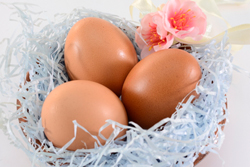Eggs are great for you… but artificial food colors are not. That’s why if you’re planning on dyeing eggs for your Easter celebration — or any occasion at all — you’ll want to stick with natural food colors.

Easter eggs should be as safe to eat as they are nice to look at
But first, to get the perfect hardboiled egg, you need to know how to cook them. If you want the perfect hardboiled egg — rule #1 is don’t let them boil! Overcooking your eggs results in a rubbery texture and cracks in the eggshells.
Also, when you let your eggs boil, a reaction between sulfur in the egg white and iron in the yolk can cause an ugly green ring around the yolk. It’s safe to eat, but not very appetizing to look at.
Courtesy of the American Egg Board, cooking the perfect hardboiled egg (they call them hard-cooked eggs because you shouldn’t actually let them continue to boil), is as simple as 1, 2, 3…
The Perfect Hardboiled Egg
Step 1
PLACE eggs in saucepan large enough to hold them in single layer. ADD cold water to cover eggs by 1 inch. HEAT over high heat just to boiling.
Step 2
REMOVE from burner. COVER pan. LET EGGS STAND in hot water about 15 minutes for large eggs (12 minutes for medium eggs; 18 minutes for extra large).
Step 3
DRAIN immediately and serve warm. OR, cool completely under cold running water or in bowl of ice water, then REFRIGERATE.
Natural Egg Coloring
Now that you have your perfectly boiled eggs, it’s time to color them naturally. Chef Jeffrey Saad from the Next Food Network Star and national spokesperson for The Incredible Edible Egg shows how you can use safe, natural ingredients like blueberries, turmeric, and coffee to color your eggs below.
Since you’ll be using natural ingredients instead of dangerous artificial colors to dye your eggs, expect your eggs to take a little longer to absorb a deep color than store bought kits. But serving a food you’re comfortable with your family eating is worth the wait.
Have a favorite natural ingredient for dyeing eggs bright colors? A tip for boiling or peeling the perfect egg? Let us know in the comments below!
Most Popular:
 Egg Whites or Whole Eggs?
Egg Whites or Whole Eggs?
The Surprising Truth…


Two additional steps to add: 1) Add at least 1 teaspoon of salt to the water the eggs boil in. It helps with the peeling process especially with fresher eggs. 2) Add a dollop of vinegar also to the water to prevent the “green ring around the yolk”. Don’t ask me why they work, they just do and I’ve been using this method for years.
Add baking soda to the water. I get eggs that are so fresh that you have to use your hands to separate them because the whites won’t just fall off the yolks, and when you put baking soda in the water they peel like a month old egg.